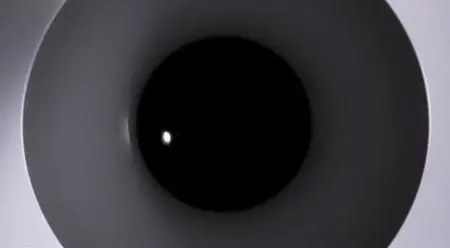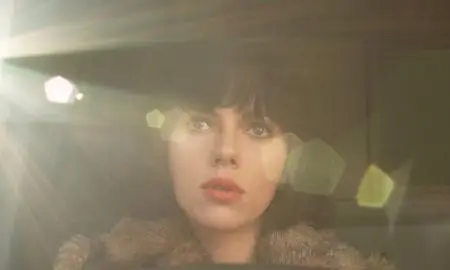SPOILERS AHEAD. If you haven't read the book or seen the film, I would suggest doing so first. The twists and turns of this narrative are pure joy.
Between Michael Faber's novel and the film adaptation written by Walter Campbell and Jonathan Glazer (directed by the latter), Under The Skin has two existences. There is a basic speculative premise shared between the two—a woman drives around Scotland, picking up men for a nefarious network—as well as a more or less similar story spine (we'll get into that in a minute). And while all other aspects of the film and the book are different, the two narratives are linked by one other (and deeply important) attribute: they are both sublime examples of the writerly adage "show, don't tell." Both Faber and Glazer—plus all others involved in the filmmaking process, including the film's lead actress Scarlett Johansson—effectively drop the reader/viewer in media res (another craft rule) and allow the plot to take us away, sparing us any tedious exposition that attempts to explain what, exactly, is happening. If we are patient, we will eventually glean more detail, but without giving too much away too soon, the authors of both narratives only answer the most important questions, leaving many up in the air, and thus up to audience interpretation.
Let's take a closer look at both versions of Under The Skin and explore how they individually and collectively show rather than tell.
The Novel
First published in 2000, Under The Skin was Scotland-émigré Michael Faber's debut novel. It revolves around the experiences of Isserley, an alien surgically-altered to appear human (and thus covered in scars), sent to Earth to work possibly the most debasing job known to her species. Because of Faber's genius writing, however, we learn these details about Isserley gradually. The author withholds grains of information as long as he possibly can, slowly revealing facets of his character entirely through action and non-expository dialogue.
Consider the novel's opening paragraph:
Isserley always drove straight past a hitch-hiker when she first saw him, to give herself time to size him up. She was looking for big muscles: a hunk on legs. Puny, scrawny specimens were no use to her.
The last sentence might look like telling, but in fact Faber is toying with us. It's important to note what Faber is not saying. Specifically, look at his use of the word "specimen." This word is often used to describe an attractive woman—i.e., "She's a beautiful specimen." So Faber is showing us, without outright telling us, that Isserley is a kind of predator here. As we read on, we begin to suspect she might be a serial killer, but as it turns out, the character seeks hunky hitchers for their lean meat. Isserley is basically a buyer at a cattle market, on the hunt for the best livestock she can find. She delivers the "vodsels" to the butchers, who fatten, slaughter and ship them off to their home planet. Thus, the word specimen takes on a whole new and decidedly more utilitarian meaning here—it isn't used figuratively, but rather as literally as it can be used. And yet, at the same time, this one word still conveys a view of these men as inhuman, which is one central theme to the narrative.
Having established his protagonist as something of a predator (and remember, at this point in the novel, we're under the impression she cruises the highlands for sexual reasons), Faber reveals an innocent side to Isserley. A few pages after the above passage, she hears a strange rattle in her car:
She listened to it, holding her breath, wondering what it was trying to tell her in its quaint foreign language. Was the rattle a plea for help? A momentary grumble? A friendly warning? She listened some more, trying to imagine how a car might make itself understood.
...No doubt it wanted to be a good car, but it had its problems.
Again, on the surface, these sentences indicate that Isserley doesn't know much about cars, which makes her relatable (how many of us truly understand the inner workings of our automobiles?). But again, we have to read between the lines here. Isserley not only displays a desire to understand what the rattle means, but through anthropomorphizing her car and showing something like worry or concern for its well-being, Faber establishes an almost childlike curiosity and innocence that persists throughout the novel. Remember, Isserley is an alien wrapped in human skin, and her actions throughout the book are less than savory. By showing us how little she knows of this world, and the horrible reasons that led her here, Faber once again toys with our emotions. We initially feel sickened by her predatory actions, but ultimately our sympathies shift, and we root for Isserley because we identify with her plight.
While many of Faber's reveals concern Isserley's character, some function purely as plot devices and hooks. The first concrete indication that otherworldly elements are at play appears a few pages after Isserley listens to the rattle, when she finally picks up a hitchhiker.
'Just south?' she enquired as she eased the car away from the kerb, careful, as always, to flip the toggle for the indicators rather than the headlights or the windscreen wipers or the icpathua.
If you're the type of reader that looks up unfamiliar words in the dictionary, you will find no entry for "icpathua." This is a non-existent word, made up as a function of Faber's world-building, but the author slides it in at the end of his sentence, as though it was just as commonplace as "headlights or windscreen wipers." No lengthy paragraphs telling us what icpathua is, what it does, and why Isserley needs it. We find out eventually, but only by seeing it in action.
Bear in mind that the entire novel unfolds this way, with Faber teasing out strange information through sensory descriptions and action rather than expository dialogue and paragraphs, making Under The Skin a most engrossing read.
The Film
Released over a decade after the publication of Faber's novel, Jonathan Glazer's 2013 film adaptation of Under The Skin departs from its source material, but only in superficial ways—chiefly, removing all names from the narrative, as well as the idea that the alien (played by Scarlett Johansson) was surgically altered to appear human. He also relocates the story from rural Scotland to Glasgow. Dialogue appears sparsely, forcing the audience to infer much of the action and reasons why the unnamed protagonist goes out in her van at night.
Make no mistake, however: the film is not vague. We are fully capable of understanding "The Female" and her desire to escape the life she's been dealt. It's just that, this is a story told predominately through visual elements rather than dialogue, allowing viewers to see the protagonist's arc.
Glazer accomplishes this by toying with the audience in a fashion similar to that of Faber's. He opens the film with Kubrickian shots of indistinct materials—possibly the interior of a white ship with a round porthole looking out into space, a blip of light off in the dark, presumably Earth (the ship's destination). Over this shot, we hear a muffled female voice practicing her pronunciation, learning to speak English. This, like the icpathua, is a hook. Glazer's tipping his audience off right away that otherworldly elements are at play here—again, without spelling anything out or directly showing any specific "spaceship" props (hibernation pods, randomly blinking machines, etc.). What we see (and briefly hear) is what we get. And we get a lot without seeing much.
This storytelling approach continues into the next scene, in which we see a mysterious man on a motorcycle pull up to a white van parked on the side of the road. He gets off his bike and disappears down a small incline, returning moments later with the body of a woman slung over his shoulders. He tosses the woman in the back of the van. Next, we're introduced to the Female, nude, engaged in stripping the woman in a stark white room. The Female dresses in the woman's clothing, a task she performs dispassionately, as though she were shredding leaves from a head of lettuce. In the following scene, the Female has a brief, silent exchange with the mysterious man, then climbs into the white van from the first scene and drives away.
Without spelling anything out, Glazer shows us that both the Female and the man are connected in some way (most likely from the same planet), that the dead woman is the Female's predecessor, and that the Female is taking her place—to what end, we still don't know, but eventually we see her cruising Glasgow's streets, looking for men. What's she doing? we ask. Is she looking for sex? Her scant dialogue seems to suggest as much. But then of course we see her motivations are far more sinister.
And yet, just as Faber before him, Glazer juxtaposes the Female's predatory actions with displays of childlike wonder and a desire to understand herself. This dichotomy is perhaps best represented in the second scene, in which the Female strips her predecessor—a cold, sterile setting, an act without tenderness (despite the tear that streams down the woman's face, suggesting she may not be dead, but merely paralyzed). The scene ends with the Female finding a small black ant. She lets it crawl along her fingers as she examines it with that childlike wonder seen in Faber's novel. When not out hunting, the Female absorbs the world with a look of innocent awe on her face that speaks louder than words (or voice-over narration) ever could. Her entire character arc—just like Isserley before her—centers around a battle between this admiration for Earth and her duties as a predator.
In this way, I would argue that Glazer's film is a perfect adaptation. Though wildly different from its source material in places, his version of Under The Skin manages to grasp the essence of Faber's novel while at the same time standing out as its own, separate entity. This gives film viewers a strong impetus to pick up the book, and readers a similar but altogether new viewing experience to enjoy. Thus, not only are the two incarnations of this narrative sublime examples of "show, don't tell," they also represent the ideal symbiosis between a novel and its screen version, between a film and its source material. Each is a perfect example of its respective medium, co-existing and co-mingling with each other.
What are your thoughts on Under The Skin, either the film, the book, or both? Did you enjoy one more than the other, or, like me, do you admire them simultaneously? Let us know what you think in the comments section.

About the author
Christopher Shultz writes plays and fiction. His works have appeared at The Inkwell Theatre's Playwrights' Night, and in Pseudopod, Unnerving Magazine, Apex Magazine, freeze frame flash fiction and Grievous Angel, among other places. He has also contributed columns on books and film at LitReactor, The Cinematropolis, and Tor.com. Christopher currently lives in Oklahoma City. More info at christophershultz.com









